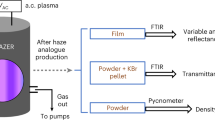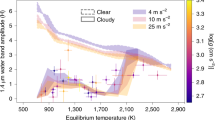Abstract
Photochemical hazes are important opacity sources in temperate exoplanet atmospheres, hindering current observations from characterizing exoplanet atmospheric compositions. The haziness of an atmosphere is determined by the balance between haze production and removal. However, the material-dependent removal physics of the haze particles are currently unknown under exoplanetary conditions. Here we provide experimentally measured surface energies for a grid of temperate exoplanet hazes to characterize haze removal in exoplanetary atmospheres. We found large variations of surface energies for hazes produced under different energy sources, atmospheric compositions and temperatures. The surface energies of the hazes were found to be the lowest around 400 K for the cold plasma samples, leading to the lowest removal rates. We show a suggestive correlation between haze surface energy and atmospheric haziness with planetary equilibrium temperature. We hypothesize that habitable-zone exoplanets could be less hazy, as they would possess high-surface-energy hazes that can be removed efficiently.
This is a preview of subscription content, access via your institution
Access options
Access Nature and 54 other Nature Portfolio journals
Get Nature+, our best-value online-access subscription
$29.99 / 30 days
cancel any time
Subscribe to this journal
Receive 12 digital issues and online access to articles
$119.00 per year
only $9.92 per issue
Buy this article
- Purchase on Springer Link
- Instant access to full article PDF
Prices may be subject to local taxes which are calculated during checkout






Similar content being viewed by others
Data availability
References
Zhang, X., Strobel, D. F. & Imanaka, H. Haze heats Pluto’s atmosphere yet explains its cold temperature. Nature 551, 352–355 (2017).
Hörst, S. M. et al. Haze production rates in super-Earth and mini-Neptune atmosphere experiments. Nat. Astron. 2, 303–306 (2018).
Arney, G. et al. The pale orange dot: the spectrum and habitability of hazy Archean Earth. Astrobiology 16, 873–899 (2016).
Gao, P. et al. Aerosol composition of hot giant exoplanets dominated by silicates and hydrocarbon hazes. Nat. Astron. 4, 951–956 (2020).
Knutson, H. A., Benneke, B., Deming, D. & Homeier, D. A featureless transmission spectrum for the Neptune-mass exoplanet GJ 436b. Nature 505, 66–68 (2014).
Knutson, H. A. et al. Hubble Space Telescope near-IR transmission spectroscopy of the super-Earth HD 97658b. Astrophys. J. 794, 155 (2014).
Kreidberg, L. et al. Clouds in the atmosphere of the super-Earth exoplanet GJ 1214b. Nature 505, 69–72 (2014).
Libby-Roberts, J. E. et al. The featureless transmission spectra of two super-puff planets. Astrophys. J. 159, 57 (2020).
Jacobson, M. C., Hansson, H.-C., Noone, K. J. & Charlson, R. J. Organic atmospheric aerosols: review and state of the science. Rev. Geophys. 38, 267–294 (2000).
Bender, F. A.-M. Aerosol forcing: still uncertain, still relevant. AGU Adv. 1, e2019AV000128 (2020).
Trainer, M. G. et al. Organic haze on Titan and the early Earth. Proc. Natl Acad. Sci. USA 103, 18035–18042 (2006).
He, C. et al. Laboratory simulations of haze formation in the atmospheres of super-Earths and mini-Neptunes: particle color and size distribution. Astrophys. J. 856, L3 (2018).
He, C. et al. Photochemical haze formation in the atmospheres of super-Earths and mini-Neptunes. Astron. J. 156, 38 (2018).
He, C. et al. Sulfur-driven haze formation in warm CO2-rich exoplanet atmospheres. Nat. Astron. 4, 986–993 (2020).
He, C. et al. Haze formation in warm H2-rich exoplanet atmospheres. Planet. Sci. J. 1, 51 (2020).
Seinfeld, J. H. & Pandis, S. N. Atmospheric Chemistry and Physics: From Air Pollution to Climate Change 2nd edn (Wiley, 2006).
Kanakidou, M. et al. Organic aerosol and global climate modelling: a review. Atmos. Chem. Phys. 5, 1053–1123 (2005).
Israelachvili, J. N. Intermolecular and Surface Forces 3rd edn (Academic Press, 2011).
Tavana, H., Petong, N., Hennig, A., Grundke, K. & Neumann, A. W. Contact angles and coating film thickness. J. Adhes. 81, 29–39 (2005).
He, C. et al. Gas phase chemistry of cool exoplanet atmospheres: insight from laboratory simulations. ACS Earth Space Chem. 3, 39–50 (2019).
Moran, S. E. et al. Chemistry of temperate super-Earth and mini-Neptune atmospheric hazes from laboratory experiments. Planet. Sci. J. 1, 17 (2020).
Vuitton, V. et al. H2SO4 and organosulfur compounds in laboratory analogue aerosols of warm high-metallicity exoplanet atmospheres. Planet. Sci. J. 2, 2 (2021).
He, C. et al. Carbon monoxide affecting planetary atmospheric chemistry. Astrophys. J. 841, L31 (2017).
Moses, J. I. et al. Compositional diversity in the atmospheres of hot Neptunes, with application to GJ 436b. Astrophys. J. 777, 34 (2013).
Yu, X. et al. Surface energy of the Titan aerosol analog ‘tholin’. Astrophys. J. 905, 88 (2020).
Slinn, W. G. N. et al. Some aspects of the transfer of atmospheric trace constituents past the air-sea interface. Atmos. Environ. 12, 2055–2087 (1978).
Emerson, E. W. et al. Revisiting particle dry deposition and its role in radiative effect estimates. Proc. Natl Acad. Sci. USA 117, 26076–26082 (2020).
Marlow, W. H. Size effects in aerosol particle interactions: the van der Waals potential and collision rates. Surf. Sci. 106, 529–537 (1981).
Monti, J. M., McGuiggan, P. M. & Robbins, M. O. Effect of roughness and elasticity on interactions between charged colloidal spheres. Langmuir 35, 15948–15959 (2019).
Hörst, S. M. et al. Laboratory investigations of Titan haze formation: in situ measurement of gas and particle composition. Icarus 301, 136–151 (2018).
Trainer, M. G., Jimenez, J. L., Yung, Y. L., Toon, O. B. & Tolbert, M. A. Nitrogen incorporation in CH4-N2 photochemical aerosol produced by far ultraviolet irradiation. Astrobiology 12, 315–326 (2012).
Köhler, H. The nucleus in and the growth of hygroscopic droplets. Trans. Faraday Soc. 32, 1152–1161 (1936).
Fletcher, N. H. The Physics of Rainclouds (Cambridge Univ. Press, 1962).
Gorbunov, B. & Hamilton, R. Water nucleation on aerosol particles containing both soluble and insoluble substances. J. Aerosol Sci. 28, 239–248 (1997).
Raymond, T. M. & Pandis, S. N. Cloud activation of single-component organic aerosol particles. J. Geophys. Res. Atmos. 107, 4787 (2002).
Wenzel, R. N. Resistance of solid surfaces to wetting by water. Ind. Eng. Chem. 28, 988–994 (1936).
Hay, K. M., Dragila, M. I. & Liburdy, J. Theoretical model for the wetting of a rough surface. J. Colloid Interface Sci. 325, 472–477 (2008).
Nishino, T., Meguro, M., Nakamae, K., Matsushita, M. & Ueda, Y. The lowest surface free energy based on –CF3 alignment. Langmuir 15, 4321–4323 (1999).
Morley, C. V. et al. Quantitatively assessing the role of clouds in the transmission spectrum of GJ 1214b. Astrophys. J. 775, 33 (2013).
Gao, P. & Benneke, B. Microphysics of KCl and ZnS Clouds on GJ 1214 b. Astrophys. J. 863, 165 (2018).
Zhang, X. Atmospheric regimes and trends on exoplanets and brown dwarfs. Res. Astron. Astrophys. 20, 99 (2020).
Rannou, P. et al. Titan haze distribution and optical properties retrieved from recent observations. Icarus 208, 850–867 (2010).
France, K. et al. The MUSCLES Treasury Survey. I. Motivation and overview. Astrophys. J. 820, 89 (2016).
Fraine, J. et al. Water vapour absorption in the clear atmosphere of a Neptune-sized exoplanet. Nature 513, 526–529 (2014).
Benneke, B. et al. A sub-Neptune exoplanet with a low-metallicity methane-depleted atmosphere and Mie-scattering clouds. Nat. Astron. 3, 813–821 (2019).
Benneke, B. et al. Water vapor and clouds on the habitable-zone sub-Neptune exoplanet K2-18b. Astrophys. J. 887, L14 (2019).
Guo, X. et al. Updated parameters and a new transmission spectrum of HD 97658b. Astron. J. 159, 239 (2020).
Edwards, B. et al. Hubble WFC3 spectroscopy of the habitable-zone super-Earth LHS 1140 b. Astron. J. 161, 44 (2021).
Cable, M. L. et al. Titan tholins: simulating Titan organic chemistry in the Cassini–Huygens era. Chem. Rev. 112, 1882–1909 (2012).
Sebree, J. A., Trainer, M. G., Loeffler, M. J. & Anderson, C. M. Titan aerosol analog absorption features produced from aromatics in the far infrared. Icarus 236, 146–152 (2014).
Schneider, C. A., Rasband, W. S. & Eliceiri, K. W. NIH Image to ImageJ: 25 years of image analysis. Nat. Methods 9, 671–675 (2012).
Extrand, C. W. & Moon, S. I. Contact angles of liquid drops on super hydrophobic surfaces: understanding the role of flattening of drops by gravity. Langmuir 26, 17090–17099 (2010).
Law, K. Y. & Zhao, H. Surface Wetting: Characterization, Contact Angle, and Fundamentals (Springer, 2016).
Owens, D. K. & Wendt, R. C. Estimation of the surface free energy of polymers. J. Appl. Polym. Sci. 13, 1741–1747 (1969).
Rabel, W. Einige Aspekte der Benetzungstheorie und ihre Anwendung auf die Untersuchung und Veränderung der Oberflächeneigenschaften von Polymeren. Farbe Lack 77, 997–1005 (1971).
Kaelble, D. H. Dispersion-polar surface tension properties of organic solids. J. Adhes. 2, 66–81 (1970).
Lifshitz, E. M. & Hamermesh, M. in Perspectives in Theoretical Physics (ed. Pitaevski, L.P.) Ch. 26 (Pergamon, 1992).
Ninham, B. W. & Parsegian, V. A. Van der Waals forces: special characteristics in lipid–water systems and a general method of calculation based on the Lifshitz theory. Biophys. J. 10, 646–663 (1970).
Maxwell, J. C. A dynamical theory of the electromagnetic field. Phil. Trans. R. Soc. Lond. I 155, 459–512 (1865).
van Oss, C. J. Interfacial Forces in Aqueous Media 2nd edn (CRC Press, 2006).
Stevenson, K. B. Quantifying and predicting the presence of clouds in exoplanet atmospheres. Astrophys. J. 817, L16 (2016).
Fu, G. et al. Statistical analysis of Hubble/WFC3 transit spectroscopy of extrasolar planets. Astrophys. J. 847, L22 (2017).
Crossfield, I. J. M. & Kreidberg, L. Trends in atmospheric properties of Neptune-size exoplanets. Astron. J. 154, 261 (2017).
Tsiaras, A., Waldmann, I. P., Tinetti, G., Tennyson, J. & Yurchenko, S. N. Water vapour in the atmosphere of the habitable-zone eight-Earth-mass planet K2-18b. Nat. Astron. 3, 1086–1091 (2019).
Kloubek, J. Calculation of surface free energy components of ice according to its wettability by water, chlorobenzene, and carbon disulfide. J. Colloid Interface Sci. 46, 185–190 (1974).
Yaw, C. L. Thermophysical Properties of Chemicals and Hydrocarbons 1st edn (William Andrew, 2009).
Kaltenegger, L. & Sasselov, D. Exploring the habitable zone for Kepler planetary candidates. Astrophys. J. 736, L25 (2011).
Acknowledgements
X.Y. is supported by a 51 Pegasi b Fellowship from the Heising-Simons Foundation. X.Z. is supported by the NASA Solar System Workings Program (grant no. 80NSSC19K0791). C.H. and S.M.H. are supported by the NASA Exoplanets Research Program (grant no. NNX16AB45G). P.M. is supported by a 3M Non-Tenured Faculty Grant. S.E.M. is supported by a NASA Earth and Space Science Fellowship (grant no. 80NSSC18K1109).
Author information
Authors and Affiliations
Contributions
X.Y., C.H., X.Z. and S.M.H. conceived the study. C.H. prepared the samples. X.Y. and C.H. performed the surface energy measurements. P.M. helped with interpretation of the surface energy measurements. X.Y. and A.H.D. performed the water amplitude calculations. X.Y., C.H., S.M.H. and J.I.M. discussed the chemistry for haze formation. X.Y. and X.Z. discussed the implication of the results for haze removal. X.Y. conducted the data analysis and prepared the manuscript. X.Y., C.H., X.Z., S.M.H., A.H.D., P.M., J.I.M., N.K.L., J.J.F., P.G., E.M.-R.K., S.E.M., C.V.M., D.P., J.A.V. and V.V. contributed to discussing the results and editing the manuscript.
Corresponding author
Ethics declarations
Competing interests
The authors declare no competing interests.
Additional information
Peer review information Nature Astronomy thanks Erika Barth and the other, anonymous, reviewer(s) for their contribution to the peer review of this work.
Publisher’s note Springer Nature remains neutral with regard to jurisdictional claims in published maps and institutional affiliations.
Supplementary information
Supplementary Information
Supplementary Fig. 1 and Tables 1–8.
Source data
Source Data Fig. 2
Statistical source data.
Source Data Fig. 3
Statistical source data.
Source Data Fig. 4
Statistical source data.
Source Data Fig. 6
Statistical source data.
Rights and permissions
About this article
Cite this article
Yu, X., He, C., Zhang, X. et al. Haze evolution in temperate exoplanet atmospheres through surface energy measurements. Nat Astron 5, 822–831 (2021). https://doi.org/10.1038/s41550-021-01375-3
Received:
Accepted:
Published:
Issue Date:
DOI: https://doi.org/10.1038/s41550-021-01375-3



